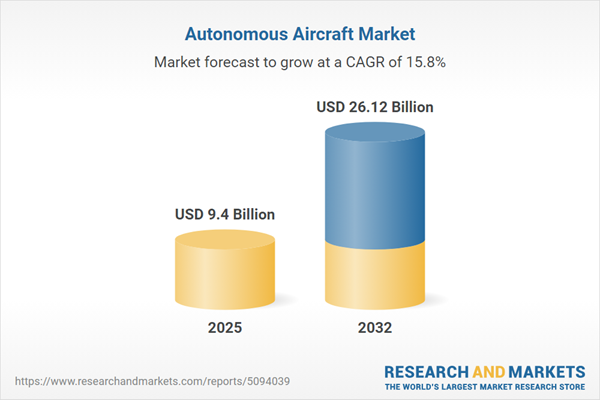Speak directly to the analyst to clarify any post sales queries you may have.
Autonomous aircraft technologies are rapidly transforming operations for commercial, defense, and industrial sectors. By enabling operational efficiency and creating new capabilities, autonomous aerial systems are opening substantial strategic opportunities for organizations ready to adopt these advanced solutions.
Market Snapshot: Autonomous Aircraft Market Outlook
The autonomous aircraft market is on a marked upward trajectory, supported by continuous advances in technology, evolving regulations, and intensified interest from both government and private entities. Autonomous aircraft are benefitting from enhanced artificial intelligence, improved sensor combinations, and robust digital simulation ecosystems. Together, these advancements expand possibilities for uncrewed applications and accelerate sector growth. Broader investment commitments are prompting new supply chain strategies and production models, ensuring flexibility and scalability across multiple application areas and regions.
Scope & Segmentation of the Autonomous Aircraft Market
- Applications: Use cases range from precision agriculture, logistics for package delivery, and emergency response to the inspection of vital infrastructure, mapping, and surveying. Each application segment brings unique challenges and pushes further demand for innovation and reliability.
- Platform Types: Market participants utilize fixed wing, rotary wing, and hybrid wing aircraft, with configurations including multirotor and tilt rotor designs. This diverse set of platforms enables tailored solutions for different mission types and operational requirements.
- Propulsion Technology: Industries are adopting electric systems (battery and fuel cell), traditional fuel options (gasoline, jet), and hybrid propulsion structures (parallel and series) to meet mission-specific demands and environmental standards.
- Component Categories: Essential components include avionics, advanced communication networks, navigation technologies, mission payloads, and propulsion subsystems—all engineered to enhance safety, performance, and integration.
- End Users: Primary user groups span commercial enterprises—such as logistics, inspection, and media—military organizations, and recreational users. Each group has distinctive compliance demands and operational boundaries.
- Operating Altitudes: Uncrewed aircraft operate at varying altitudes, from low urban corridors to high-altitude long-range missions, optimizing their deployment based on platform specifications and intended outcomes.
- Geographic Regions: Market coverage includes the Americas, Europe, Middle East & Africa, and Asia-Pacific. Stakeholders must navigate differing regulatory regimes and market entry considerations within these regions.
- Leading Companies: Prominent market participants include Da-Jiang Innovations Science and Technology Co., Ltd., General Atomics Aeronautical Systems, Inc., Northrop Grumman Systems Corporation, The Boeing Company, Lockheed Martin Corporation, Airbus S.A.S., Textron Inc., Leonardo S.p.A., Elbit Systems Ltd., and AeroVironment, Inc.
Key Takeaways for Decision-Makers
- Increased capabilities in avionics and propulsion are facilitating faster integration of autonomous platforms in both established and new operational settings.
- Industry collaboration with regulatory bodies is resulting in clearer certification processes that help accelerate the deployment of autonomous systems within regulated airspace.
- Machine learning, together with digital twin modeling, is being leveraged to refine predictive maintenance, support extended fleet operation, and optimize tactical mission planning.
- Prioritizing cybersecurity is essential; investments in encrypted communication systems and intrusion detection are improving both operational trust and resilience.
- Manufacturers are pursuing production efficiencies through just-in-time models and strategic industry alliances, responding to volatility in supply chains and raw material sourcing.
Tariff Impact on Supply Chains and Sourcing
- Current trade policy changes and component tariffs are prompting manufacturers to strengthen procurement, diversify supply channels, and move towards domestic or nearshore production as a risk mitigation strategy.
- Dual-sourcing, increased inventory reserves, and local partnerships are being employed by industry leaders to bolster resilience against supply chain interruptions on a global scale.
Methodology & Data Sources
This analysis is informed by direct interviews with aerospace executives, regulators, and market end users. Secondary research draws from technical journals, authoritative government documents, and industry white papers, while patent reviews, procurement analysis, and operational case studies ensure robust, actionable findings.
Why This Report Matters
- Offers an in-depth, data-driven perspective on technology shifts, market opportunities, and regional trends guiding strategic development in the autonomous aircraft sector.
- Equips leadership teams with practical segmentation, competitive insights, and regulatory benchmarks to confidently guide organizational investments and planning.
Conclusion
Organizations that adapt to changing standards, enhance supply chain agility, and leverage digital technologies will strengthen their positioning within the evolving and competitive autonomous aircraft market.
Additional Product Information:
- Purchase of this report includes 1 year online access with quarterly updates.
- This report can be updated on request. Please contact our Customer Experience team using the Ask a Question widget on our website.
Table of Contents
3. Executive Summary
4. Market Overview
7. Cumulative Impact of Artificial Intelligence 2025
List of Figures
Samples

LOADING...
Companies Mentioned
The key companies profiled in this Autonomous Aircraft market report include:- Da-Jiang Innovations Science and Technology Co., Ltd.
- General Atomics Aeronautical Systems, Inc.
- Northrop Grumman Systems Corporation
- The Boeing Company
- Lockheed Martin Corporation
- Airbus S.A.S.
- Textron Inc.
- Leonardo S.p.A.
- Elbit Systems Ltd.
- AeroVironment, Inc.
Table Information
| Report Attribute | Details |
|---|---|
| No. of Pages | 186 |
| Published | October 2025 |
| Forecast Period | 2025 - 2032 |
| Estimated Market Value ( USD | $ 9.4 Billion |
| Forecasted Market Value ( USD | $ 26.12 Billion |
| Compound Annual Growth Rate | 15.7% |
| Regions Covered | Global |
| No. of Companies Mentioned | 11 |









